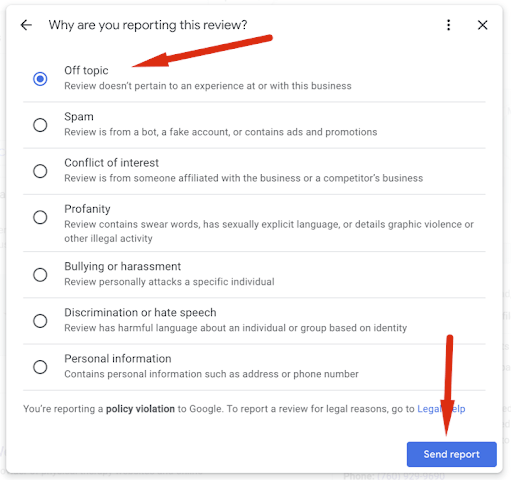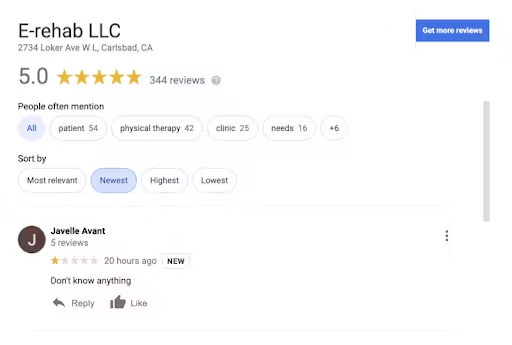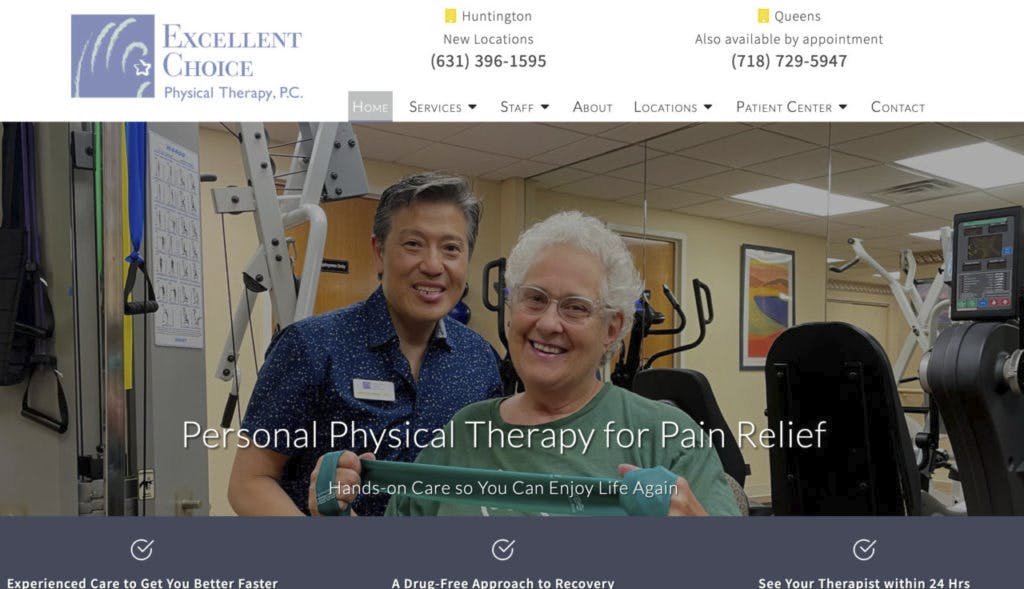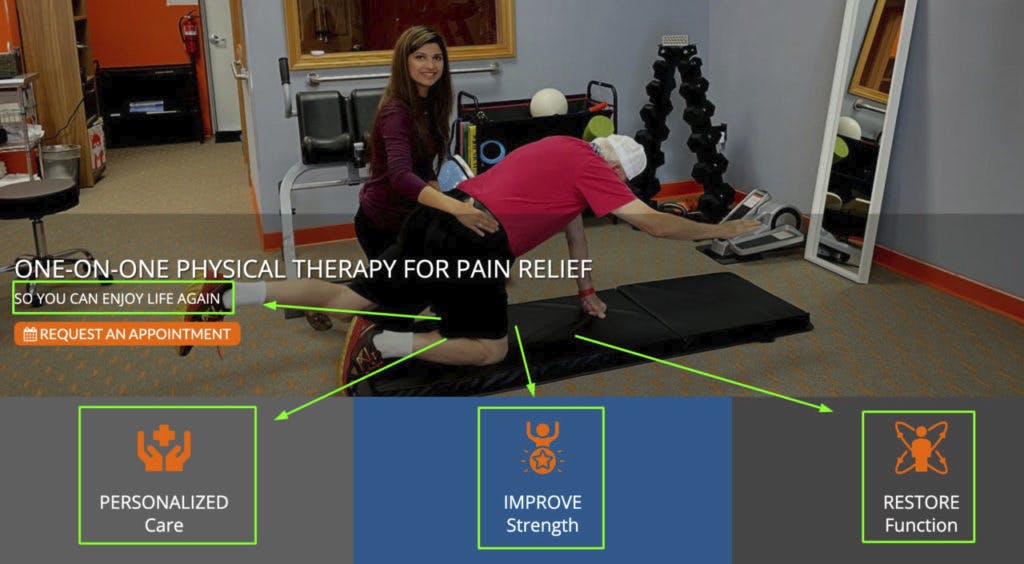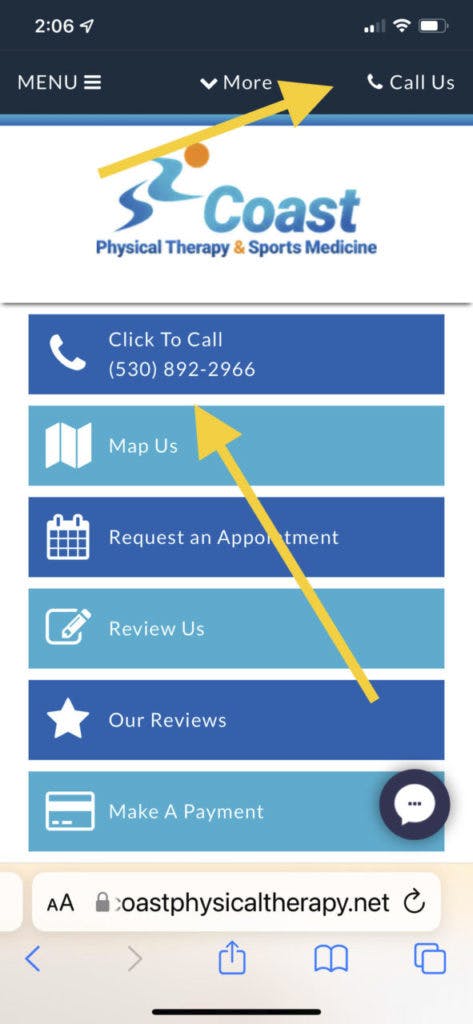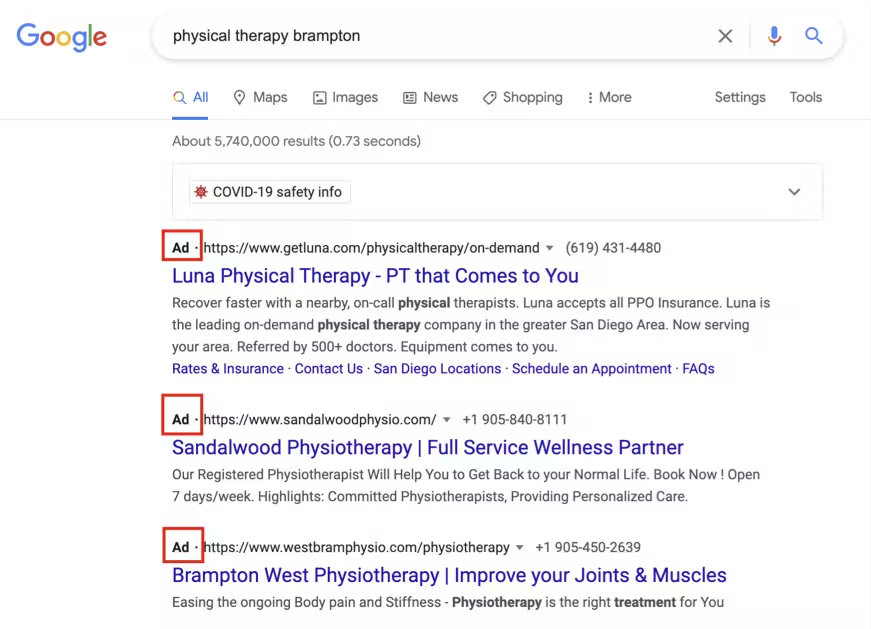Having worked with over 2000 practices, generated over 100,000 appointment requests and over 600,000 phone calls, we’ve continued to evolve our physical therapy marketing services based on data, feedback, patients case studies, and client wants and needs.
Below you’ll find four tips, based on considerable experience, that will help you develop a better PT private practice website and convert more prospects that are considering you, into paying patients. Here are some of our recommendations.
I. Put Some Time Into It – Provide Content that Prospective Patients Want

In a service business like physical therapy, people judge what they can’t see (e.g. the quality of your service) based on what they can see (i.e. a great looking, fast, easy to use, website with clear communication, is extrapolated by viewers, as a representation of the quality of your PT services).
I am just floored at the number of mistakes I see on so may physical therapy websites. Younger PT owners, that spend more of their time on social media than searching for services, often make these mistakes. They’re more interested in funnels and Instagram than the marketing opportunities that are right in front of them.
Here are some examples to name a few:
- No attention to detail – misspelled words and inconsistent/inaccurate information,
- Large paragraphs that never get read,
- A practice website that make viewers hunt for and/or work very hard just to find their address & phone number,
- Little to no use of quality media like service photos, video, or interactive educational tools,
- Websites that were down in-house with little to no experience or strategic forethought.
Do you know how many people visit your website each month? Is it 100, 300, 500 or more? With those kinds of numbers, why would you do something fast, cheap, or get a website from a company that has no idea how the physical therapy market works?
Here are some basic things you need to do to address problems right away.
Think Like a Patient When Analyzing Your Physiotherapy Website
When someone visits your home page, the most visited page on your website, you need to
tell a memorable story. Don’t make it all about yourself, understand who the real hero is…it’s the patient.
- Have you ever thought about what’s on a patient’s mind when they are visiting your website?
- What questions are they pondering?
- Are they comparing you to someone else?
- Are they simply wanting to know how to contact you?
- Are they questioning whether the services they’ve been referred for are worth their time and money?
Try This Simple Exercise

Here’s a simple exercise you can do to answer these questions. Ask 4-5 of your patients if they visited your website and if they did, ask them open questions like:
- What were they looking for and did they find it?
- When did they visit during their buying process?
- Why did they visit?
- How could you done things better?
- What did they like and what can you improve with physical therapy website design?
By simply putting yourself in the mindset of your website users and asking them a few questions, you’ll get some good insight about how it’s used.
A Word of Caution – Don’t let the tail wag the dog. Feedback from 4-5 patients is just that, feedback from an n=5. It’s a small sample and may not bet representative of the 200+ visitors that are viewing and using your PT website every month.
Make sure their feedback makes sense. For example, I once heard from a PT that they included summaries of social posts on their home page and patients loved them. Maybe this is true for some patients, but you might want to ask, “How many times did you visit our website?” to better clarify the first question.
Most won’t visit anymore than once or twice. They aren’t likely to re-read your home page content unless they are returning months or years later.
So, is it really that important to have a social media post feed on your home page? Maybe, but not likely. Will potential patients choose you still without it?
There isn’t a right or wrong answer. I’m simply suggesting that you consider the bigger picture when making tactical, online content decisions for your home page, beyond the feedback of a few patients.
II. Use Your Own Physical Rehab Website Photos (including PT, OT, Speech photos)

I want to share a quick story here, about a PT owner that spent $17,000 on her PT website. $17,000 – that’s a lot of money and a long time to recover your ROI. When I compared her website to ours, fundamentally & technically (I.e. speed, on -page SEO, etc.), they were very similar to what we here at E-rehab create for a fraction of the cost.
There was one main difference though – the photos. On the home page there were nice images of patients and staff, and each internal page had a service photo, and the staff images were well done too. Certainly, it wasn’t worth $16,000 more than what E-rehab charges though.
Here’s my point. It’s 2021. With modern iPhones, and Android phones, you can shoot phenomenal photos. Some movie directors have shot independent films only with iPhones.
Another reason to use your own photos is that prospective patients want to see you. Moreover, they want to see the smiling faces of patients like them. Remember, your patients are the heroes in your story and you are the expert, empathetic guide. Click here to read more about our StoryBran-based methodology recommendations for your home page.
Donald Miller mentions in his book Marketing Made Simple, that people that see themselves in they story and photos you are telling on your website, are more likely to buy. It’s called narrative transformation, and a big step toward accomplishing this transformation is including your own photos.
NOTE: there are times when a stock photo can do the job almost as well. Images from product vendors about your aquatic equipment or how a high intensity lasers works are a couple of examples. However, it’s always best to use your own photos.
Take an extra few minutes to take your own photos. It will be a simple way to gain a competitive advantage over many of your physical therapy private practice website competitors….and you certainly don’t need to spend $17,000 to get it done.
III. Mobile Optimize Your Website to Help Execute Other Online Marketing Strategies

When we look at the analytics across hundreds of PT websites, we see that about 50 percent of your visitors are on smartphones. Check your web analytics (we provide those to all of our customers at no additional cost), and you’re likely do see the same.
As I mentioned above, I’m just floored at the lack of quality and the mobile user experience on so many PT websites. Often they look poor without any attention to design detail. Often the content is long, run-on paragraphs that are really hard to read.
I’ve seen the converse as well. Wix or Squarespace websites that have little to no content at all. When I question the current owner about this, I’ve heard more than once, no one wants to read stuff on our website. My counter question is, “Tell me the average age of your patients?”
It’s almost always people in their 40s, 50s, 60s, 70s, or older. They indeed want to read a memorable story about you to find out if you are an expert, do you have a caring staff, do you treat their problem, have others had with their diagnosis had success? The take-home message here is you need to match the right type of media (i.e. a good website) with your market (your average users).
Other common problems on mobile sites:
- I’ve seen videos that run off the page,
- No click-to-call functionality or mapping functions,
- No facilitation of reviews or social following
…all important functions that your mobile optimized website should offer its users.
So, take a look at your website on iPhone and Android devices. Does it represent the quality of the physical therapy services that you deliver or does it fall short?
You can’t afford to make this mistake, especially if you are competing agains the large corporations that have spent 5-figures on their website and have full-time staff members that oversee their design, form, and function.
IV. Have More Than an Online Brochure – Differentiate Your Practice

Here’s the stereotypical physical therapy website. On the home page is one of two kinds of content.
1. The “Our Mission” Content – it’s all about the practice, doesn’t tell a story, is often brief with trite statements like “we are the best…”
2. The “Misaligned Sales” Message Content – On this type of home page, you find workshops, some typical copywriting like the “treat yourself for free” ebooks (that suggest the practice would rather teach you how to care for yourself and spam you in exchange for your email address, rather than have you come into the clinic for care,) and then some mixed message videos.
Rather than sharing platitudes or dissuading your viewers from connecting with you, follow a specific formula – tell a memorable story, that funnels viewers to a call to action.
Realize that by the time a potential patient gets to your home page, they generally aren’t asking:
“Is physical therapy is right for me?”
They are probably asking themself:
“Is your physical therapy practice the better choice compared to the clinic right down the street?”
Take the opportunity to differentiate and educate with tools like:

A. A Nice Introductory Video. Shoot an expert interview confirming they are at the right website; or answer the question why you are the right choice and share what makes you better.

B. Social Proof. Make sure you have testimonials. You don’t need long paragraphs or 60+ of them on your home page. On the contrary, post short testimonials that answer the most common objections your view might have. Objections to using your practice might include the amount of time it takes for care, the cost, travel time, insurance coverage, appointment availability, and expertise.

C. A Differentiation Table. You’ve seen these when shopping for products like software. Create a table and by comparison, feature your strengths and expose your competition’s weaknesses.

D. Include a Chat Bot that Educates Rather than Misleads. I’ve seen chat bots that portray themselves as being a live service. Not only is this illegal in some states, they often push the viewer toward an appointment rather than educating them on the value of your physical therapy services. Half of consumers that visit your website don’t trust you. Rather thank trying to sell them on your PT services, educate them and motivate them choose you with good patient education.

E. Describe the Recovery Process. If a website viewer of yours has never experienced physical therapy before (and that might be 50-70% of new initial evaluations), show them what the recovery process is like. Share what they will be experiencing that will take them from pain and dysfunction to recovery and wellness.
In closing, I am shocked that even in 2021, so many small PT private practices completely miss the mark when it comes to online marketing. Only after wasting lots of time and money looking for the marketing “silver bullet”, do some circle back to tried and tested strategies to convert more physical therapy web viewers into patients.
Give the above tips a try and let us know what you think.
If you’d like help designing and developing your physical therapy website, give us a call.
Let us help you get more PT online marketing right. Contact us today at 760-585-9097 or click here to schedule an appointment.

